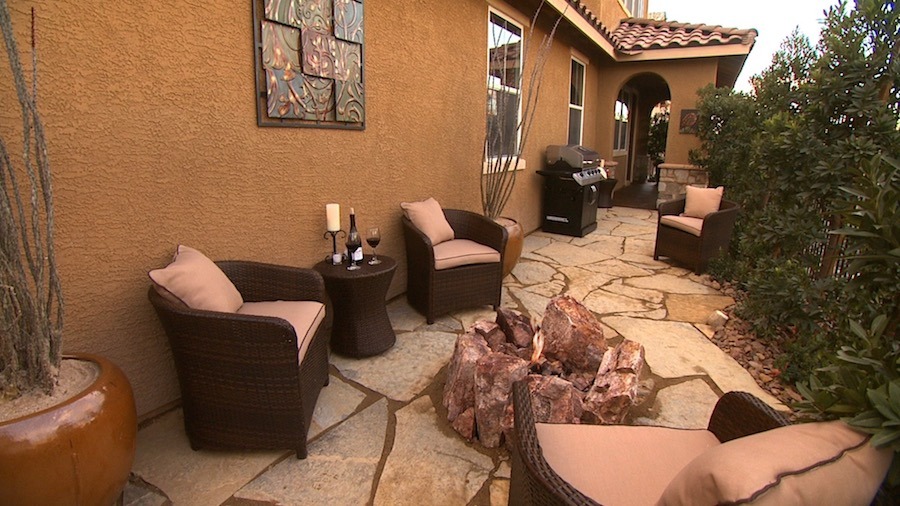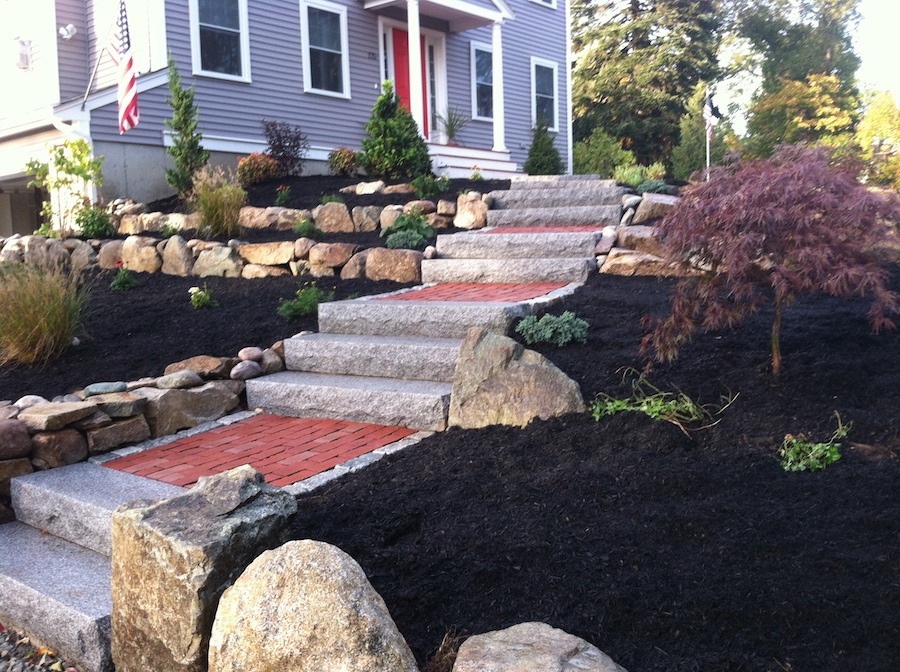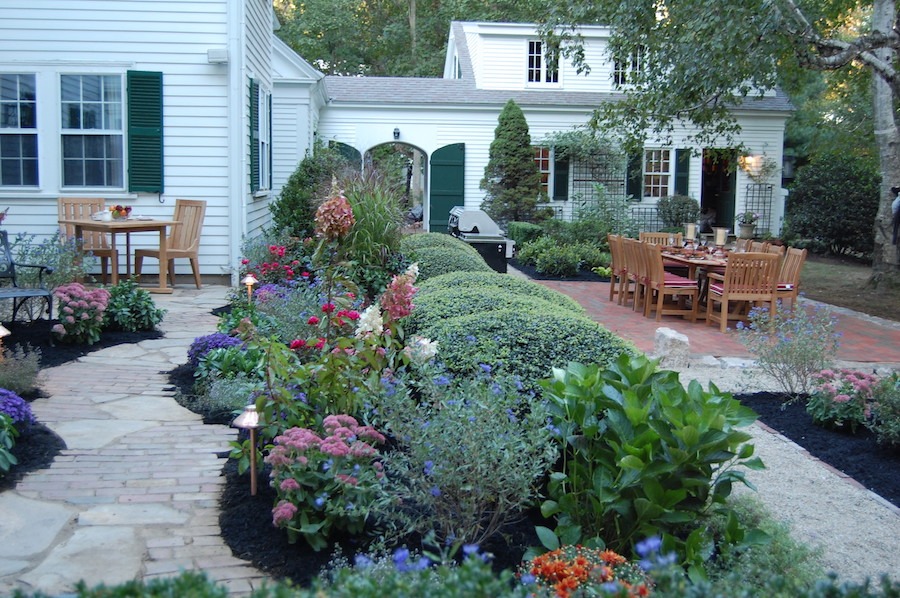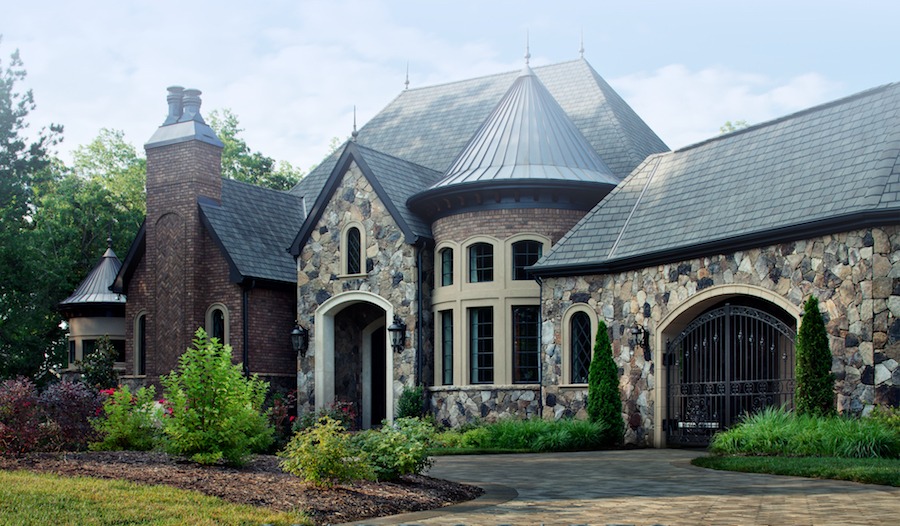 About the Author: As a second generation stone mason and designer I have continued the trade my father, Arthur Stearns, taught me. Learning everything from hand cutting full veneer stones to designing outdoor living spaces I continued my family’s business for twenty-five years. Co-hosting national televisions shows for DIY’s “Rock Solid” “Indoors Out” and PBS’ “Victory Garden” I started to build projects around the country with my cousin, Dean Marsico. Hired as a co-host for the “World Of Concrete” over several years exposed me to the international world of construction. Today I am the Marketing Manager at Plymouth Quarries in Hingham, MA., where my father started cutting stone in 1950. Working at Plymouth Quarries brings me full circle back to the place where it all began. I am committed to helping trade schools reach the next generation of tradesmen and women.
About the Author: As a second generation stone mason and designer I have continued the trade my father, Arthur Stearns, taught me. Learning everything from hand cutting full veneer stones to designing outdoor living spaces I continued my family’s business for twenty-five years. Co-hosting national televisions shows for DIY’s “Rock Solid” “Indoors Out” and PBS’ “Victory Garden” I started to build projects around the country with my cousin, Dean Marsico. Hired as a co-host for the “World Of Concrete” over several years exposed me to the international world of construction. Today I am the Marketing Manager at Plymouth Quarries in Hingham, MA., where my father started cutting stone in 1950. Working at Plymouth Quarries brings me full circle back to the place where it all began. I am committed to helping trade schools reach the next generation of tradesmen and women.
Over the years I have seen a look of confusion when the term hardscaping comes into a conversation. Those of us who work in the business of outdoor projects tend to throw this term around as if everyone knows what we are talking about. Even as I type this article my spell check continues to underline the word hardscaping telling me to change it to landscaping. When we understand what hardscaping is then we will recognize how it has been incorporated into our lives for centuries. Not to get too nostalgic here but when humans rolled the first stones into place to create a fire, they started hardscaping.
In our need to understand what hardscaping is, I would get questions like; “Is a patio considered a hardscape?” “Are boulders hardscaping?” “What about walkways, walls, firepits etc.?” If you answered yes to all of these, you are correct. Any use of natural or manufactured materials, other than living materials such as plants, trees, shrubs etc, falls into the never-ending category of hardscape. And by the way, when hardscape and landscape come together it’s one of the best couplings since peanut butter and chocolate. All those great photographs of outdoor projects usually have elements of both hardscape and landscape. The hardscape comes first. It is the skeletal structure that gets enhanced by landscape, outdoor lighting, cooking units, furniture, fire and water.
So now that we have defined what a hardscape is, I want to take you into the options of what you can dream of, design and build. When you think of it, every idea starts as a dream. No one says, “I want to build a patio with boring, washed out materials that represent the characteristics of non-fat milk.” Most of us say, “I want to build a great patio, with an outdoor water feature, walls and plants that create color all season long…let’s see what I can afford?” The afford part is when the reality comes in, but the dream is what starts it all. That first thought, the wish list, is what all of us should keep in mind as we begin creating a hardscape.
Over the years, in my business of outdoor design, we have educated our clients with the idea of “phasing out.” See, any project can be phased out to meet needs of budget requirements, but without the overall wish list then our creating becomes stifled.
What is the overall goal of a great hardscape project? I would say “To have the homeowner take pride in their property, add value to their property and to create a space that represents their tastes and interests.”
We all know too well the projects around our homes that are either done incorrectly or don’t reflect what we want. How many times have you been fed up with that one area around your house and you find yourself ripping it up, digging away without a plan as to what you are going to do? You just know you can’t look at it anymore and your frustration turns to action. Maybe wasted action but at least you feel like you are moving in the right direction. I have been a victim of this myself but over the years I have learned that I need to step back and put a plan together to get the best results for my home. Our homes are the biggest investments of our lives as well as being an extension of who we are. So why not dream when it comes to the ideas? Why not phase out the project so that in three to four years it all comes together? Why not take the time to put that plan together?
The list of materials we can work with in hardscaping seems endless. Again any natural or manufactured solid material from A-Z makes that list. It can be overwhelming for anyone to pick products, but added onto that are the choices of what you can do with all of these products. I have seen over the years clients become paralyzed with making a decision. For them it is like walking into a tile store and being bombarded with every option possible. We have to remember that the use of any of these materials gives us complete freedom to create whatever is best for the property. What is best is when we consider the end result of the choices.
For example, we fall in love with a product but it is completely wrong for the architecture and style of the home; we overdesign a smaller area because we want it to be something bigger; or we overbuild a project and blow the budget knowing we will never get that value back. All bad ideas resulting in a failed hardscape project.
The best advice we would give to a client is “Tell us what you don’t like.” That’s the place to start.
Then we can begin the process of elimination. It is much easier to figure out what you don’t like before you can figure out what you do like. This way of thinking also helps one get out of that paralyzed state and make some decisions. The fear of making the wrong decision results in making no decision. As a designer/installer of these projects it is important to know how to keep moving things forward.
When my cousin Dean Marsico and I landed the television hosting jobs for Rock Solid and Indoors Out on the DIY Network, we found ourselves on a plane every few weeks traveling to the next project. Working on projects from Boston to Texas, California, Florida, Nebraska, North and South Carolina, Colorado, Maryland, Georgia, Nevada, Illinois, Indiana, Arizona and Oklahoma we have seen our share of hardscapes.
Each state had completely different tastes and techniques. In Arizona, I remember front yards with varieties of round and crushed stones, flagstones for walkways and very minimal landscaping – all due to the heat and the water restrictions. The hardscape represented the region and the indigenous products that came from that area.
As I took notice of each area around the country I started seeing common rules that make a great hardscape. As a second generation stone mason and designer these rules came into focus; some from watching how my father created to discovering new techniques with the ever-changing world of design.
Following these simple tips will keep any hardscape from getting off track:
Tip #1: FUNCTION
Every project needs a function. What is the need of the hardscape? Eating area, living room, cooking area, a reading spot, lounge area or even a place to escape. All of these have a function. Once you know what the area is for then every decision you make will support that or go against it. Knowing the function of the area has to be the first thing you do.
Tip #2: THE RULE OF 3
No more than three products in one space. When you start moving into that fourth product the space can begin to look like something out of a masonry showroom. If you are looking for lots of color and areas full of interesting artifacts, then you can always do that with landscape and furniture; but when it comes to the hardscape keep it simple and no more than 3.
Tip #3: INDIGENOUS PRODUCTS
Always try to incorporate hardscape materials that are from the region you are working in. Having been raised in New England there are certain products that ring true to my hometown area. You can still think out of the box with these materials and be as creative as you want, but try to at least have something in the hardscape that feels like it has been on your property. As if it belongs to the property.
Tip #4: MIX MATERIALS
Mix stone with brick, concrete materials with natural materials, decorative stone with porcelain or smooth boulders set into flagstones. You get the idea. Even today you will see projects still standing that are built with a mix of materials because that is what was available. Europe is full of structures mixing stone and brick together creating it’s own unique look.
Tip #5: LANDSCAPE
Every space needs some form of landscape. It can be very minimal to full gardens that bloom in every season. Landscape does nothing but enhance any hardscape. For example one of the big trends these days are Hostas. Groups of different Hosta species creates an interesting, low maintenance garden that will last until the first frost.
Tip #6: DRESS IT UP
Every hardscape needs some dressing. You can do this with furniture, outdoor lighting, fire, water, music, outdoor paintings, rugs, outdoor clocks etc…It is endless how to dress a space. Again it goes back to function and what the space is for.
You will find as you continue to work either in this profession or on your home as a weekend warrior, you will develop your own way of creating the hardscape of your dreams.
Below are some examples of different hardscape projects and the process behind them:
 This Las Vegas hardscape is in a tight area 11’ wide x 15’ long. Imagine the shape of a bowling alley. The patio was flagstone from the area, the small amount of thin veneer stone around the base of the column was a limestone blend and the fire pit was a red rustic rock from the mountain regions in the area. This space has all the makings of a great hardscape – function, the rule of 3, indigenous materials, simple design, true to the architecture of the home. Also in this area the restrictions on open fires is tough so this fire pit has a small can of gel that creates a flame when lit; all resulting in what is right for the area and the property.
This Las Vegas hardscape is in a tight area 11’ wide x 15’ long. Imagine the shape of a bowling alley. The patio was flagstone from the area, the small amount of thin veneer stone around the base of the column was a limestone blend and the fire pit was a red rustic rock from the mountain regions in the area. This space has all the makings of a great hardscape – function, the rule of 3, indigenous materials, simple design, true to the architecture of the home. Also in this area the restrictions on open fires is tough so this fire pit has a small can of gel that creates a flame when lit; all resulting in what is right for the area and the property.
 This countryside hardscape fills the need of front steps to this new property. The grade issue here was high enough to create a ten-step unit that is spread throughout the overall thirty feet of length in the walkway. The gray Antique Granite contrasts against the red City Hall Paver brick and the rustic boulders help create tiers to hold back the grade as well as elevated gardens. The landscaping is a minimal phase taking in the homeowners desire to add more landscaping each year.
This countryside hardscape fills the need of front steps to this new property. The grade issue here was high enough to create a ten-step unit that is spread throughout the overall thirty feet of length in the walkway. The gray Antique Granite contrasts against the red City Hall Paver brick and the rustic boulders help create tiers to hold back the grade as well as elevated gardens. The landscaping is a minimal phase taking in the homeowners desire to add more landscaping each year.
 This New England outdoor dining area is an extension of this 100 yr old property. The softer Nantucket red brick create the dining area as a mix of flagstone and brick create the walkway and breakfast nook through out the mature gardens. River Bed Stone walkways lined with Cobblestone add a loose walking path making the space feel older and not so formal.
This New England outdoor dining area is an extension of this 100 yr old property. The softer Nantucket red brick create the dining area as a mix of flagstone and brick create the walkway and breakfast nook through out the mature gardens. River Bed Stone walkways lined with Cobblestone add a loose walking path making the space feel older and not so formal.
 Some suburban hardscapes can be very simple, like this one. The need was an area for eating and hanging out. The Mill Stone concrete pavers create a lived in look with the mix of rectangular and square shapes. An old cut off piece of Granite curbing is set as a step and a few decorative boulders add character. The simple furniture and gardens keep it low maintenance for the homeowner.
Some suburban hardscapes can be very simple, like this one. The need was an area for eating and hanging out. The Mill Stone concrete pavers create a lived in look with the mix of rectangular and square shapes. An old cut off piece of Granite curbing is set as a step and a few decorative boulders add character. The simple furniture and gardens keep it low maintenance for the homeowner.
Hardscaping is all around us. There are many hardscapes that are simpler and some that are more elaborate than what you have seen here. Every home has a need for some kind of hardscape even if it is just a landscape garden with boulders. Homeowners and top designers can create any type of hardscape. Your budget is up to you and based on how dirty you like to get. Sweat equity is a great way of keeping your costs down. Planning is another way and of course lining up the right people or hiring the right crew doesn’t hurt.
Years ago I would drive down this same road in my hometown of Weymouth, MA and I would pass by this older gentleman working on his front yard. Now I knew his front yard because for a long time it was full of piles of stone. Each pile was a different size of stone. For years I would drive by thinking, “What is going on with this house?” “What’s with these piles of stones?” “Someone should clean this thing up.” Then one day I drove by and there he was working in his yard.
He was very slow and took his time working on the piles. He wore a big hat, he would walk with his cane and he always seemed to be in a good mood. I couldn’t figure out what he was doing. It took weeks for me to see some results and then his yard, his hardscape, started to take shape. He was getting rid of all the grass in his front yard and replacing it with different designs of these stones. Each size stone was in the same area with designs creating circles, curves and straight lines; like a mosaic painting or a tapestry.
It took him all of one summer to get all the stones put into the design he saw. When he was done I would drive by very slowly to get a better look at this yard. It was unbelievable. The time and planning he took to get there was clearly thought out. His front yard was a hardscape that fell into the category of functional art. It wasn’t my taste for my property but I couldn’t deny the organization, time and effort it took for him to finish his project. He kept this front yard organized and clean.
Every spring I would see him out there fixing an area that the previous winter had disrupted. Then after some time I noticed that the design was not looking so good. It wasn’t being kept up. No one was out there putting the stones in their place. After a year or so it had become overgrown. I never saw the older gentleman again and even though his project had changed I can see him out there working, bringing value to his home, taking pride in what he was doing. All those days he did it for himself as I drove past going to the job building for the next client. I realized he and I had something in common; we both wanted to build a great space that made us proud, brought value to the home and was unique to who owned it. Isn’t that the point of it anyway?
